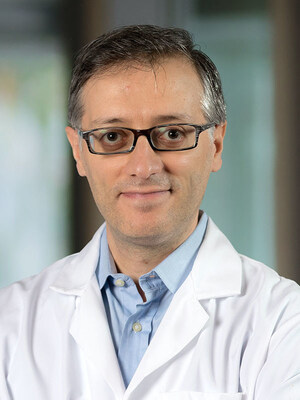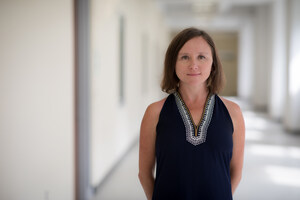BRONX, N.Y., Sept. 22, 2014 /PRNewswire-USNewswire/ -- A new study by researchers at Albert Einstein College of Medicine of Yeshiva University suggests that measuring how fast the brain responds to sights and sounds could help in objectively classifying people on the autism spectrum and may help diagnose the condition earlier. The paper was published today in the online edition of the Journal of Autism and Developmental Disorders.
The U.S. Centers for Disease Control and Prevention estimates that 1 in 68 children has been identified with an autism spectrum disorder (ASD). The signs and symptoms of ASD vary significantly from person to person, ranging from mild social and communication difficulties to profound cognitive impairments.
"One of the challenges in autism is that we don't know how to classify patients into subgroups or even what those subgroups might be," said study leader Sophie Molholm, Ph.D., associate professor in the Dominick P. Purpura Department of Neuroscience and the Muriel and Harold Block Faculty Scholar in Mental Illness in the department of pediatrics at Einstein. "This has greatly limited our understanding of the disorder and how to treat it."
Autism is diagnosed based on a patient's behavioral characteristics and symptoms. "These assessments can be highly subjective and require a tremendous amount of clinical expertise," said Dr. Molholm. "We clearly need a more objective way to diagnose and classify this disorder."
An earlier study by Dr. Molholm and colleagues suggested that brainwave electroencephalogram (EEG) recordings could potentially reveal how severely ASD individuals are affected. That study found that children with ASD process sensory information—such as sound, touch and vision—less rapidly than typically developing children do.
The current study was intended to see whether sensory processing varies along the autism spectrum. Forty-three ASD children aged 6 to 17 were presented with either a simple auditory tone, a visual image (red circle), or a tone combined with an image, and instructed to press a button as soon as possible after hearing the tone, seeing the image or seeing and hearing the two stimuli together. Continuous EEG recordings were made via 70 scalp electrodes to determine how fast the children's brains were processing the stimuli.
Watch Dr. Molholm discuss her research.
The speed with which the subjects processed auditory signals strongly correlated with the severity of their symptoms: the more time required for an ASD individual to process the auditory signals, the more severe that person's autistic symptoms. "This finding is in line with studies showing that, in people with ASD, the microarchitecture in the brain's auditory center differs from that of typically developing children," Dr. Molholm said.
The study also found a significant though weaker correlation between the speed of processing combined audio-visual signals and ASD severity. No link was observed between visual processing and ASD severity.
"This is a first step toward developing a biomarker of autism severity—an objective way to assess someone's place on the ASD spectrum," said Dr. Molholm. "Using EEG recordings in this way might also prove useful for objectively evaluating the effectiveness of ASD therapies."
In addition, EEG recordings might help diagnose ASD earlier. "Early diagnosis allows for earlier treatment—which we know increases the likelihood of a better outcome," said Dr. Molholm. "But currently, fewer than 15 percent of children with ASD are diagnosed before age 4. We might be able to adapt this technology to allow for early ASD detection and therapy for a much larger percentage of children."
The paper is titled "Neurophysiological Indices of Atypical Auditory Processing and Multisensory Integration are Associated with Symptom Severity in Autism." Other authors are lead author Alice Brandwein, M.D., John Foxe, Ph.D., Hans-Peter Frey, Ph.D., Juliana Bates, Ph.D., and Lisa Shulman, M.D., all at Einstein, and John Butler at Trinity College, Dublin, Ireland.
The study was primarily supported by a grant from the National Institute of Mental Health (MH085322). The authors report no conflicts of interest.
About Albert Einstein College of Medicine of Yeshiva University
Albert Einstein College of Medicine of Yeshiva University is one of the nation's premier centers for research, medical education and clinical investigation. During the 2013-2014 academic year, Einstein is home to 743 M.D. students, 275 Ph.D. students, 103 students in the combined M.D./Ph.D. program, and 313 postdoctoral research fellows. The College of Medicine has more than 2,000 full-time faculty members located on the main campus and at its clinical affiliates. In 2013, Einstein received more than $150 million in awards from the National Institutes of Health (NIH). This includes the funding of major research centers at Einstein in aging, intellectual development disorders, diabetes, cancer, clinical and translational research, liver disease, and AIDS. Other areas where the College of Medicine is concentrating its efforts include developmental brain research, neuroscience, cardiac disease, and initiatives to reduce and eliminate ethnic and racial health disparities. Its partnership with Montefiore Medical Center, the University Hospital and academic medical center for Einstein, advances clinical and translational research to accelerate the pace at which new discoveries become the treatments and therapies that benefit patients. Through its extensive affiliation network involving Montefiore, Jacobi Medical Center –Einstein's founding hospital, and three other hospital systems in the Bronx, Brooklyn and on Long Island, Einstein runs one of the largest residency and fellowship training programs in the medical and dental professions in the United States. For more information, please visit www.einstein.yu.edu, read our blog, follow us on Twitter, like us on Facebook, and view us on YouTube.
Logo - http://photos.prnewswire.com/prnh/20120531/DC16559LOGO
SOURCE Albert Einstein College of Medicine
WANT YOUR COMPANY'S NEWS FEATURED ON PRNEWSWIRE.COM?
Newsrooms &
Influencers
Digital Media
Outlets
Journalists
Opted In






Share this article